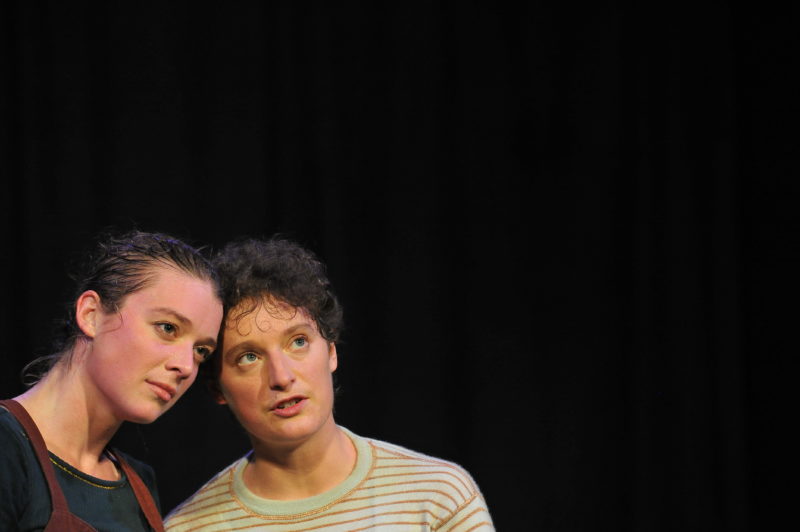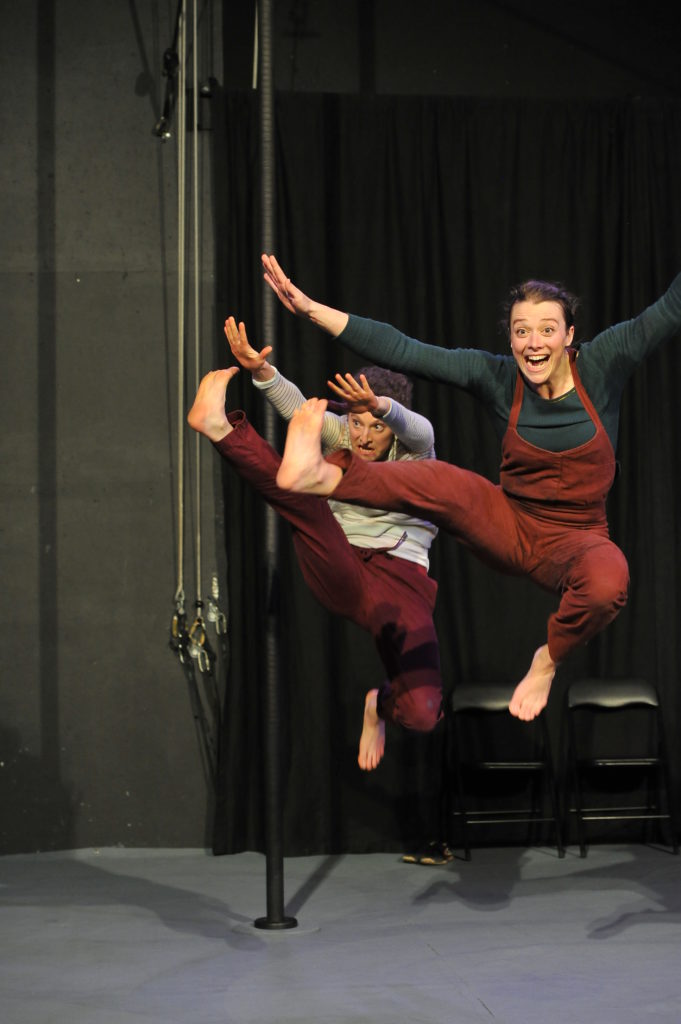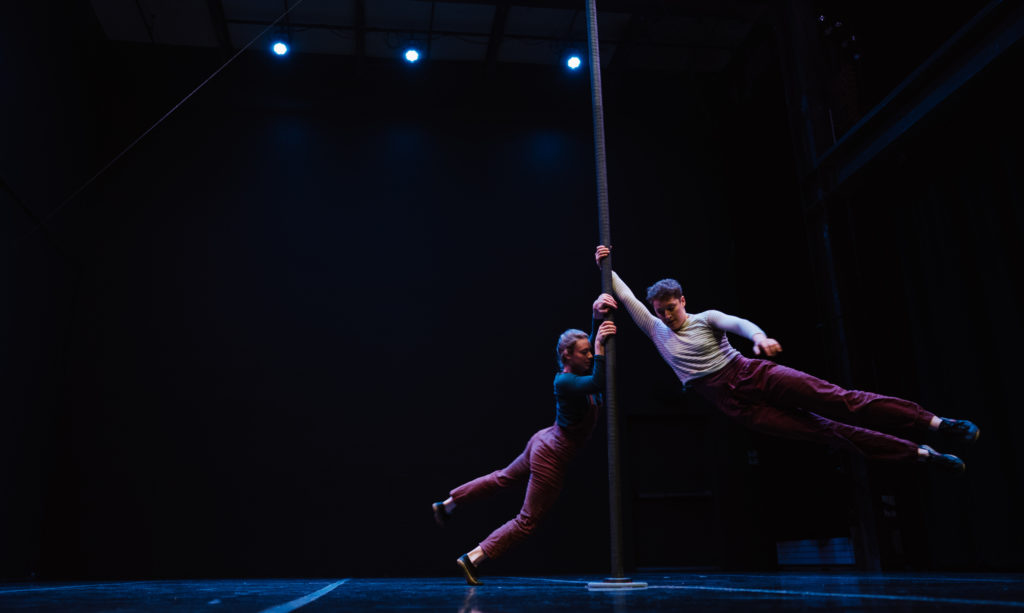
On January 25, 2018, Molly and Aviva Rose-Williams performed Side by Side at Paufve Dance’s 8x8x8 performance series at The Uptown in Oakland. I was there that night and have also watched the footage (deftly videographed by Erin Halley) multiple times to try to put my finger on why I consider it a perfect work. An engaging mixture of sensibilities and movements drawn from circus (spectacle!) and minimalist, postmodern dance (anti-spectacle!), Side by Side is six satisfying minutes of comedic intimacy. I was most moved by the moments when Molly and Aviva engage in brief gestural conversations, enlarging the gesture space beyond face, head, shoulders, arms, and hands to include the whole body.
Molly and Aviva Rose-Williams are Berkeley natives and also twin sisters. Their most recent collaboration, Mind the Gap, performed at Kinetic Arts Center where Molly and Aviva are 2019 resident artists, builds on the Side by Side to explore the pleasures and pains of being twins—the unparalleled intimacy, sometimes marked by playful exuberance and mutual support, other times an uncomfortable mirror to be covered with a sheet and hidden in the corner (read: they adore each other and also benefit to a degree from living on nearly opposite sides of the world). I brought my kids, 12 and 6, to that show, and all three sets of eyeballs were glued to the stage, a rare successful intergenerational performance outing—in other words, not one of us stood up to shout, “THIS IS SOOO BORING. CAN WE LEAVE?” (Yes, one of my children did that at a performance, I kid you not.) With technique, wit, and fearless vulnerability (is there any other kind?), Molly and Aviva charmed us all.
The twins grew up with parents who Aviva says, “both appreciate the arts and both feel like anything’s possible.” Early on they trained in circus, first with Splash Circus Theatre and later as members of the San Francisco Youth Circus from 2006 to 2009. After attending Berkeley High, Aviva and Molly auditioned for the National Circus School in Montreal, a grueling, four-day experience that resulted in neither being accepted. Aviva: “It was awful. They cut people as the days go on, so if you’re left at the end, you’ve seen all of your friends get cut. Mol got cut and we were auditioning together, so she ended up having to come in just for the hour that I needed her to do our act. It was so unpleasant.” When Aviva was sitting in the canteen with the final 30 auditioners, a young man rushed in. Aviva: “He had his coat over his head, got on his hands and knees, and started running around the canteen whispering, ‘There’s a circus school in Quebec! Come audition. Auditions are next week. Tell everyone about it!’ Though I came back to the Bay Area to study nursing at USF, I realized, ‘Oh! There’s another circus school in the world.’”
Molly spent three months in Bolivia and then went off to Middlebury College. Aviva spent an unfulfilling year at USF and training in the professional acrobatics program at the San Francisco Circus Center before following the advice of that “crazy guy.” She auditioned at École de Cirque de Québec, got in, got on a plane, and never turned back. Upon graduating with a degree in Chinese Pole in 2013, Aviva and cohort-mates Helene Leveau, Benjamin Renard, and Constanza Sommi, formed the circus collective À Sens Unique (“one-way”), and relocated to Renard’s hometown of Le Mans, France. (I highly suggest you pause your reading and watch a few À Sens Unique videos on YouTube to get a feel for their charming blend of circus arts and physical theater.) Aviva currently resides in Brussels but tries to visit the Bay Area as much as her tour schedule allows.

Molly started dancing in college, and continued, somewhat to her surprise, after graduating. Side by Side was the first piece the two made together—a test-run of sorts to see what might happen if they were to bring these parts of their lives that had developed separately from one another back together. Mind the Gap, a full-length show, felt like the natural next step.
One of the themes of Mind the Gap is the geographical and psychoemotional distance the twins have experienced since graduating high school. Much of the verbal text in the show explores the sisters’ mutual but not always simultaneously experienced urge to individuate from each other. In a gorgeous moment in the piece, Molly unwinds herself from an intertwining duet and says, “Every time we separate it feels like my heart is being ripped out of my chest and part of me is being hollowed away. But without all these miles between us, I don’t think I could have ever learned how to be by myself.” Then Aviva says, “Or with other people,” and Molly says, “Or with other people.” The way they look at each other is as two separate souls, one softened into a deep pool of understanding and care into which the other can see herself shine. Throughout the work, we see them take turns being the reflective water for the other.
This loving listening appears in the partnering, the unison work, the easy laughter, and the generous turn-taking on stage. Watching Molly and Aviva perform, and listening to them talk, their sororal love illuminates the space around them—like in Frozen! (except without the imbalance of one sister having ice powers and the other heteronormative desires).
What follows is some back-and-forth between Molly and Aviva. You’ll notice my absence—these two clearly have had a lot of practice talking to each other.
On their creative process
Molly: Before every performance, Aviva and I would set intentions or questions: what are we curious about, what do we want to find within the experience? I hadn’t realized until we were doing that together that I do that myself when I perform solos. But doing it together and having the conversation every time, we would actively decide to think about pacing and energetic flow or about what it means to perform the piece from where we are right now as opposed to where we were when we created the movement.
Aviva: Mol’s extremely articulate. All I can think of is a cardboard box next to you, simple and bland when it comes to articulation.
Molly: [Laughs.] The entire piece relies on feeling the realness of our relationship. And yet there was almost a distancing from our real life relationship and a leaning in to our artistic, creative collaboration that needed to happen in order for the relationship to feel really alive in the show. Something that’s been so exciting about working with Aviva is finding a collaborator who can match and expand my physical interests as well as having a completely different creative domain in terms of how we might use a physical language to convey or investigate something.
On the roles of dance and circus
Molly: My whole life growing up I did acrobatics, played soccer. It always felt like there was something external about the physical experience. When I started dancing I feel like I actually met my body. My first dance class was with Andrea Olsen at Middlebury—experiential anatomy. There was very little so-called dancing. It was mostly touching our bodies, finding how things worked, exploring ranges of movement. As I started to investigate a new relationship with my moving body, I realized there was also incredible capacity and potential in dance for the athleticism I had grown up loving. Now that I have these skills I can actually feel it when I’m doing it.
Aviva: The thing I find most interesting about working in circus is finding everything that’s in between the things that people have already found. Especially on pole, I’ve noticed there are specific positions you can get in and normally a trick is getting from point A to point B. How do you change point B so it’s something that’s never been seen? How do you rewrite these things and make them unexpected? This goes towards dance: how do you change rhythm and change a body’s buoyancy in space so that it becomes unexpected? Then for the performance, you have to figure out what you’re communicating with all of that. That’s where I think my work veers towards dance because it really is movement exploration.

On generating movement
Molly: We approach movement exploration really differently, which was one of the hardest parts of the creation process. My experience of your approach is that it has a lot more to do with pathways and I’m interested in felt experience and a broader narrative element, the experience of the energy, and the experience of the event, which is more intangible. Your process is more concrete in a way that can be shared between two people.
Aviva: I feel like creating movement and creating things in general are a series of choices. And in general you can’t make bad choices. Any choice that you make can become something else over time or reinspection. For me to get to a reexamining I just need to create something and find the logic within it when I’m working with other people.
Molly: Hearing you describe it that way, in some ways our process is not that different. I feel like your body and intellect have a more harmonious relationship and your intellect doesn’t stifle your body as much as mine does. The relationship between my intellect and body is not quite as intimate, the translation isn’t as easy so I have to take more distance and then come back to it later. Our physical process is somewhat similar, but mine happens over a longer period of time.
Aviva: One of the things I loved the most about working with Mol—and I loved a lot of things—is being able to come in as a circus person from a very specific environment, and be like we’re making something. It didn’t have to be circus or dance or theater. We can use our voices. We can use guitars. We both thought that if there were risks we weren’t able to take before, this is a great place to take them.
On the audience
Molly: Maybe this is my projection but I feel like everyone wants to connect and most of the choices we make every day of our lives are somehow related to the desire to connect with others. I think it would be silly to think someone was making art in a process completely devoid of that desire. Art is a really beautiful way to connect with others and to connect with ourselves.
Aviva: Coming from circus I’ve seen the opposite where people love training, they love the physical engagement with their body, they love how it makes them feel, they love the way that it makes them look to themselves and a lot of performance that I’ve seen also feels like just a step, if you train this much and you want to validate it then you need to perform to make money so the performance doesn’t feel that important, it’s a way to validate their training experience which is really a connection to their body. There’s not much riding on any sort of connection.
I had one final question for Molly and Aviva: What was the driving question for Mind the Gap?
Aviva: A lens of oneness through our twinship to talk about oneness with all people.
Molly: Where did we come from? And where are we now?
This article appeared in the June 2019 issue of In Dance.


